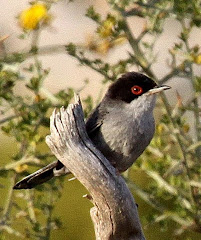April 22-27, 2012:
After what had been a cold and very wet winter, this week fortunately coincided with superb weather with blue skies and temperatures into the eighties for the whole time. Based mostly in south-west Cyprus at Nikoklea, much time was spent within the local area looking at several forms of wildlife with additional visits to the Akrotiri district, Cedar Valley, and the Troodos.
Woodchat, Asprokremnos
It was good to see three separate species of Shrike including six Woodchats at the Akrotiri gravel pits and four others below the Asprokremnos dam, two sightings of Masked Shrikes at Cedar valley and Akrotiri, and a Red-backed Shrike on the overhead wires at Ayia Varvara. Here also on other wires was a very friendly Little Owl whilst a Great Spotted Cuckoo was continuously harassed by up to six Magpies.
Masked Shrike, Akrotiri
Red-backed Shrike, Ayia Varvara
Little Owl, Ayia Varvara
Great Spotted Cuckoo, Ayia Varvara
At the Phassouri reed beds (Akrotiri) there were Glossy Ibises, Cattle Egrets, Little Ringed Plovers, Spur-winged Plovers, Wood and Green Sandpipers, Ruff, Coot and a single Ferruginous Duck.
Glossy Ibises, Fassouri
Little Ringed Plover, Fassouri
A rather distant Ferruginous Duck, Fassouri
Spur-winged Plovers, Fassouri
The isolated churchyard of Ayios Georgios in the desert-like habitat near Akrotiri acts as an oasis for incoming migrants and had attracted several Collared and Spotted Flycatchers as they passed through the island; there was also a Kentish Plover nearby The steep chalk cliffs at Tunnel beach were searched for raptors and produced a Peregrine along with a brief view of an Eleonora's Falcon, probably an immature bird, as it flew along the cliff face.
Collared Flycatcher, Akrotiri
Spotted Flycatcher, Akrotiri
Eleonora's Falcon, Tunnel Beach
Coastal pools near to the airport had Grey and Purple Heron perched in the surrounding tamarisks shrubs, Squaccos by the waterside with Wood Sandpipers and a Little Crake on the muddy margin. At one point an Osprey came in off the sea to be mobbed by Hooded Crows. Other raptor sightings elsewhere included a Bonelli's Eagle at Kidasi and a distant view of the recently-reported Pallid Harrier at Mandrea.
Purple Heron
Osprey harassed by Hooded Crow
Earlier in the week two Collared Pratincoles hawked for insects over stubble fields at Mandrea and on the last day one of them could be seen perched distantly on some off-shore rocks
Collared Pratincole hawking for insects, Mandrea
Collared Pratincole, Mandrea
The scrub below the Asprokremnos dam is another haven for both migrants and residents such as Cyprus and Sardinian Warblers and Crested Larks. A Stone Curlew flew through here briefly and there were also Whinchats, Ortolan Buntings and Northern Wheatear (as well as several Woodchats).
Sardinian Warbler, Asprokremnos
Whinchat, Asprokremnos
Amother friendly Woodchat at Asprokremnos







.jpg)




.jpg)



.jpg)
.jpg)


.jpg)
.jpg)
.jpg)
.jpg)
.jpg)
.jpg)
.jpg)
.jpg)
.jpg)
.jpg)
.jpg)
.jpg)
.jpg)
.jpg)
.jpg)
.jpg)
.jpg)
.jpg)
.jpg)
.jpg)
.jpg)
.jpg)



